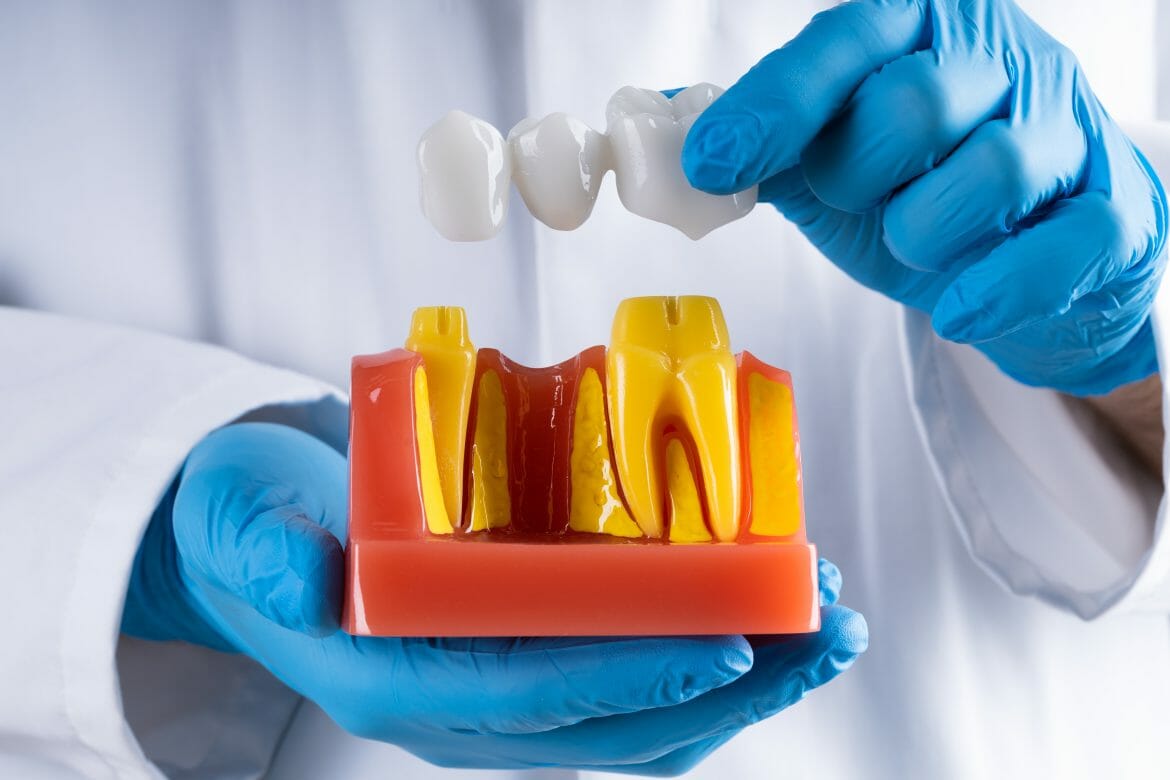Your smile is so important, and being able to confidently share it is beneficial to both you and those around you. Yet, when missing one or more teeth, self-consciousness can set in and cause you to avoid it altogether.
Fortunately, you have options today when it comes to improving your smile and your overall oral health. One such option is a dental bridge, which can make all the difference in your appearance and help you get your confidence back.
What is a Dental Bridge?
A dental bridge is a solution for bridging the gap between one or more of your missing teeth. It is basically a prosthetic for your mouth, filling an empty space not only to enhance your appearance but also improve your dental health.
The bridge works by securing one or more “false” teeth to the surrounding teeth. That is to say, it is supported by your natural teeth or dental implants.
Essentially, the dental bridge consists of three parts:
- Abutment Teeth (the teeth on each side of where the bridge will go, providing support and strength to hold the bridge in place)
- The bridge apparatus itself
- The Pontic (the false teeth that are part of the bridge)
These dental bridges are made from metal, porcelain, and ceramic and can closely match the natural color of your surrounding teeth. In most cases, it is permanently put in place and non-removable.
Benefits of a Dental Bridge
A dental bridge is a solid solution for missing teeth and the gaps they cause. More specifically, the benefits of a dental bridge include:
- Recreates your smile
- Restores both chewing and speaking ability, which can be affected by missing teeth
- Redistributes the bite force of your teeth
- Prevents collapsing or drooping of your facial structure and returns it to its natural shape
- Prevents your remaining teeth from drifting or shifting out of position to accommodate the missing space
What to Expect When Getting a Bridge
Knowing what to expect when getting a bridge can help ease any anxiety or concern you may have. Parts of the procedure may differ depending on the type of bridge you choose and where it is located within your mouth, but basically, you can expect the following steps.
A Thorough Dental Exam
Your dentist begins by conducting a thorough examination, identifying whether your teeth are healthy and strong enough to support a dental bridge. Adequate bone support is also imperative.
Preparation of Abutment Teeth
Preparation of the abutment teeth that will be on each side of the bridge occurs next, including the removal of any decay. These teeth may also need re-contouring, which involves the removal of enamel to make room for a crown. Some patients will need to undergo implant surgery in order to have abutment teeth that are strong and secure enough to hold the bridge in place.
Taking of Dental Impressions
Once the area is ready, your dentist will then take dental impressions to serve as a model to create the crowns, bridge, and pontic. The impression is then sent to a professional dental lab for the actual making of your bridge.
Fitting of a Temporary Bridge
Your dentist next fits you with a temporary bridge to wear as a way to protect the newly exposed gums and teeth. Temporary bridges look like your real teeth, but will not be as strong, so you’ll need to be careful with them, especially when eating.
Bridge Placement
Upon your return visit, removal of your temporary bridge occurs, and the area will be cleaned. The new bridge, either made of metal or porcelain, will then be inserted.
Your dentist will take considerable time to check and adjust the bridge, ensuring that the fit is as proper as it can be and doesn’t cause excessive discomfort for you. Once the fit looks proper, an adhesive will affix the bridge in place. This adhesive will be a temporary one for a few weeks, allowing time to ensure the fit is indeed correct.
Follow-Up Appointments
You will usually require follow-up visits to check the fit of the bridge and make any necessary adjustments to improve your bite. Once you have the right fit, your dentist will cement the bridge permanently in place.
Recovery and Healing
Following the procedure, you can expect soreness and tenderness due to the recontouring of teeth, placement of crowns, and insertion of the bridge itself. Your gums may bleed and feel tender as well. This discomfort should disappear within a few days.
Learn More About Dental Bridges by Contacting Bateson Dentistry Today
Dental bridges can make all the difference in your smile, your ability to chew and speak, and your overall dental health. Dr. Angela Bateson and her team here at Bateson Dentistry can provide you with the information you need to determine if this is the right option for you or help you find another solution. Call our office in Findlay today and learn more.

